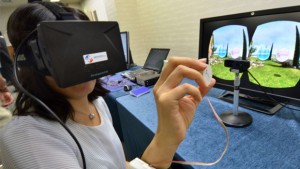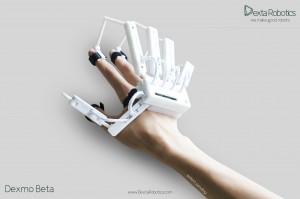Our interactive cinema project flourishes in the middle of a series of virtual reality industry advances, which creates endless possibilities. These possibilities should be explored by the VR experts in order for the audience to be adequately immersed but also to open new doors for better constructed narrative worlds to be built upon them. The gimmick impression that Virtual Reality has created in the audience’s eyes is justified up to a certain degree. The visual experience was technically inefficient, thing that could (and still can) cause fatigue and nausea, but also pretty basic in terms of the incorporated story and its interactivity evoking the audience’s boredom and disinterest.

Woman using haptic stimuli in VR
The conducted research during the past week, showed that the demand for a more complex but simultaneously more interactive virtual world for the viewers is the key element that will alter the status of virtual reality. The interactive nature of VR should be enhanced and thus not only supported by auditory and visual devices but also haptic ones. Immersion can be achieved through providing the gamer/viewer with a realistic environment in which he/she can orientate himself/herself and rely on sight, hearing but touch as well. The element of tactile feedback should be centralized since the other senses have been “persuaded” adequately with the latest progress in head mounted devices. Therefore, touch and temperature should be considered as points of departure for formation of new experiences. The equivalence of viewing yourself in the virtual world is the first step towards reaching a far more immersive reality where the user can interact with the environment. The user needs to feel immersed and forget the distinction between the and the virtual. As it happened to the experiment “Enhancing Virtual Immersion through Tactile Feedback” conducted in Honolulu in 2014, the tactile feedback was based on the user’s ability to feel the object in terms of temperature. The color implementation helped specify the user’s correspondence of temperature and color. Blue signified cold and red signified warm, as expected. However, even this basic relation between temperature and color in VR gives out a sense of reality since the feeling in both contexts comes closer to the real one.
This observation was picked up by VR companies which prototyped devices that simulate the sense of touch in VR. H wever, these devices are there to offer the audience with a fully functioning avatar but the user is half-immersed since he/she won’t be touching any of the virtual objects that he/she will be encountering. Therefore, the Holy Trinity of the tactile aspect of VR can be texture , temperature and weight. If at least two out of three can be incorporated in VR then the user’s brain will convince of the “authenticity” of the experience. The transition from the passive touch (when the environment interacts with the user but not vice versa) to the illusionary sense of freedom of touching can be technically difficult to perfectionate but small steps should be achieved towards that direction.
Last but not least, the haptic technology which is on the rise right now with a variety of sensory devices such as vests, gloves(i.e see Dexmo) and foot and wearable controllers will be on the market soon. Therefore, the tactile element should be the catalyst in a complex and interesting narrative virtual world not the other way around.
Works Cited:
Ziat, Mounia, Taylor Rolison Rolison, Andrew Shirtz, Daniel Wilbern, and Carrie Anne Balcer. “Enhancing Virtual Immersion through Tactile Feedback.” Http://dl.acm.org/. N.p., Oct. 2014. Web. Sept. 2015.







